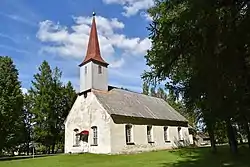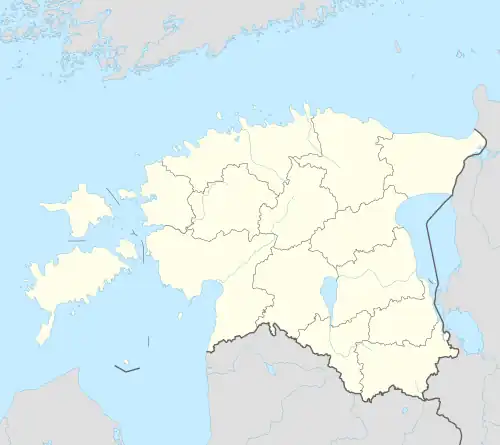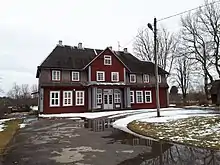Vändra | |
|---|---|
Borough with a municipality status | |
 Vändra church | |
 Flag  Coat of arms | |
 Vändra Location in Estonia | |
| Coordinates: 58°39′15″N 25°2′13″E / 58.65417°N 25.03694°E | |
| Country | |
| County | |
| Administrative centre | Vändra |
| Area | |
| • Total | 3.28 km2 (1.27 sq mi) |
| Population (2016) | |
| • Total | 2,191 |
| • Density | 670/km2 (1,700/sq mi) |
| Website | www.vandra.ee |
Vändra (German: Fennern) is a borough (Estonian: alev) in Põhja-Pärnumaa Parish in Pärnu County, Estonia. It has a population of 2,191 (in 2016) and an area of 3.28 km² (1.27 sq mi).[1]
Sights
On Old Church Hill there is an underground cemetery called Kabelias, which was used from the 15th to the 18th century, which today is under heritage protection.
Vändra church, dedicated to St. Martin, belongs to the EELK Vändra Martin parish, located in Kirikumäe in the village in 1787. The church built in 1841 is single-aisled, the tower was added in 1841.
A memorial stone has been erected over the former wooden church and manor.[2] The Vana-Vändra manor house is a ruin, the town's stage stands in the park.
The Uue-Vändra manor house was located on the banks of the Käru river, which was burned down during the 1905 revolution and was destroyed in the Second World War after the Paide road rolled. The former location of the manor is surrounded by the old and species-rich Rõusa Park, which also houses the central building of the Vändra Forestry.
In front of the school building is a statue of the Vändra bear, which was donated to the school by the alumni association of the Vändra Gümnaasium (Vändra Gymnasium).[3]
The school garden was built in 1924. It has fruit trees, rock garden, sample beds of summer and perennial flowers and a heated greenhouse. In 2004, a fountain was built in the school garden for its 80th anniversary.[4]
Composer Mihkel Lüdig, who spent the last years of his life in Vändra and was buried in the Vändra cemetery, is commemorated by a memorial plaque standing on the wall of the house opposite the buildings of the former school for the deaf.
History
Vändra was first mentioned as a village in 1515 in Wenderskull. Vändra manor was built in the second half of the 16th century. Since the year 1884, local landowners Ditmars divided the manor into Vana-Vändra manor and Uue-Vändra manor.[5]
Southeast of Vändra, Suurejõi, there was a small industrial center by the Pärnu River, where there was a water mill and earlier, a copper factory. At the beginning of the 19th century, the Vändra glass factory was established in the current Võidula manor, which ended its work only in the days of the Republic of Estonia. Vändra became the economic and cultural center of Pärnumaa. The railway reached Vändra in 1928. With nearly 1,000 inhabitants, it was one of the largest church settlements in Estonia.
On September 13, 1945, Vändra received the status of a town. From 1950 to 1962, Vändra was the district center. Vändra received the status of a municipality in 1993.

Notable people
- Karl von Ditmar (1822–1892), Baltic-German geologist and explore
- Tanel Kangert (born 1987), professional cyclist
- Alar Laneman (born 1962), politician
- Artur Lind (1927–1989), biologist
- Mihkel Lüdig (1880–1958), composer
- Ain-Ervin Mere (1905–1969), military officer implicated in the Holocaust trials in Soviet Estonia[6]
- Andres Metsoja (born 1978), politician
- Agnes Oaks (born 1970), ballet dancer
- Anton Õunapuu (1887–1919), teacher, soldier and founder of the Boy Scouts movement in Estonia
- Tarvo Seeman (born 1969), chess player
- Ants Vaino (1940–1971), racing driver
- Johann Voldemar Jannsen (1819–1890), journalist and poet
References
- ↑ "Population figure and composition". Statistics Estonia. Retrieved 29 January 2010.
- ↑ . 2010-06-19 https://web.archive.org/web/20100619095807/http://www.maaleht.ee/news/uudised/elu/maaleht-esitlebnbsp-ainus-naine-kes-on-vandras-karu-nainud.d?id=31434411. Archived from the original on 2010-06-19. Retrieved 2023-11-11.
{{cite web}}: Missing or empty|title=(help) - ↑ "Pärnu Postimees 19 september 2007 — DIGAR Eesti artiklid". dea.digar.ee. Retrieved 2023-11-11.
- ↑ "Õpetajate Leht : Õpetajate Leht". opleht.ee (in Estonian). 2023-10-15. Retrieved 2023-11-11.
- ↑ J. Holsting, O. Niinemäe. Crank up. Estonian Book, Tallinn, 1986
- ↑ Estonian reference Archived 2011-07-22 at the Wayback Machine
External links
- Official website (in Estonian)